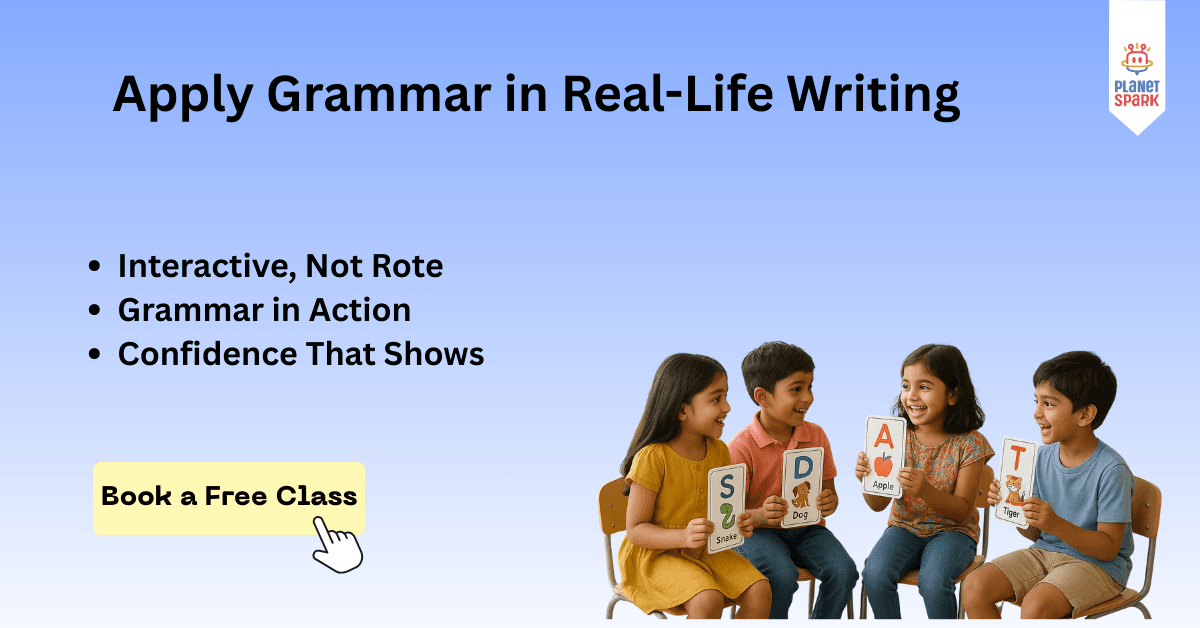Linking Verb: Definition, Examples, and Complete Grammar Guide

Table of Contents
- What is a Linking Verb?
- Define Linking Verb
- Linking Verb Meaning with Examples
- Linking Verbs List (Complete Reference)
- Linking Verb Examples Sentences
- Linking Verbs vs Action Verbs
- Linking Verbs vs Helping Verbs
- How to Identify a Linking Verb
- Rules of Using Linking Verbs
- Common Mistakes with Linking Verbs
- Linking Verbs in Different Tenses
- Linking Verbs in Literature and Writing
- Exercises on Linking Verbs
- Linking Verbs in Different Contexts
- Linking Verbs Across Languages
- Linking Verb Anchor Chart for Students
- Advanced Usage of Linking Verbs
- PlanetSpark English Grammar Course for Kids
- Frequently Asked Questions (FAQs)
When learning English grammar, verbs play a central role. They are the heartbeat of every sentence. Some verbs express action, while others serve a different purpose. This is where the linking verb comes in. Instead of showing what the subject does, it tells us what the subject is or feels.
In this comprehensive guide, you’ll learn:
What is a linking verb (definition and meaning)
Linking verb examples in sentences
Complete list of linking verbs used in English
Difference between linking verbs and action verbs
Common mistakes students make with linking verbs
Practical exercises and worksheets
Importance of linking verbs in writing and communication

What is a Linking Verb?
A linking verb is a verb that connects the subject of a sentence to information about the subject. Instead of showing an action, it links the subject to a complement (a noun, pronoun, or adjective).
Examples:
She is my friend.
The cake smells delicious.
They were tired.
Here, is, smells, were are linking verbs. They do not express action but show a state or condition.
Define Linking Verb
If you want to define linking verb in the simplest words:
A linking verb is a verb that acts as a bridge between the subject and what describes it.
It works like an equal sign (=) in math.
He is smart → He = smart.
The food tastes spicy → Food = spicy.
Confused by concepts like linking verbs? Join PlanetSpark’s English Grammar Course and make learning simple and fun.
Linking Verb Meaning with Examples
The meaning of linking verb is tied to description and identity. Unlike action verbs that show what we do, linking verbs show what we are or feel.
Examples:
The sky looks clear.
She became a teacher.
They remain hopeful.
In all cases, the verb does not perform an action but connects the subject to more detail.
Linking Verbs List (Complete Reference)
Below is a categorized linking verbs list:
Forms of to be:
am, is, are, was, were, be, being, been
Sense Verbs (used as linking verbs):
look, taste, smell, sound, feel
If your child struggles with grammar rules, PlanetSpark mentors can help.
Sign up for the English Grammar Course and build confidence step by step.
Other Linking Verbs:
become, seem, appear, grow, turn, remain, prove, stay
Chart Example:
| Category | Linking Verbs | Example Sentence |
|---|---|---|
| To Be | is, am, are | She is a dancer. |
| Senses | look, taste | The soup tastes good. |
| Other | seem, become | He became famous. |
Linking Verb Examples Sentences
Here are linking verb examples in sentences to clarify usage:
She is an artist.
The music sounds pleasant.
They were friends.
The soup tastes salty.
He became angry.
The flower smells fresh.
I feel nervous before exams.
The child grew quiet.
The story seems true.
The night was dark.
👉 Tip: Try replacing the verb with “is” or “was.” If the sentence still makes sense, it’s a linking verb.

Linking Verbs vs Action Verbs
This is a common confusion for learners.
Action Verb: Shows what the subject does.
She runs daily.
Linking Verb: Describes the subject’s state.
She is tired.
Example of Dual Use:
Action: I smell the roses. (action of smelling)
Linking: The roses smell sweet. (describes roses)
PlanetSpark’s interactive classes turn boring rules into exciting learning.
Linking Verbs vs Helping Verbs
Another tricky area is the difference between linking and helping verbs.
Linking Verb: Connects subject to complement.
Example: He is a doctor.
Helping Verb: Helps the main verb form tense/voice.
Example: He is reading a book.
So, is can be linking or helping, depending on usage.
How to Identify a Linking Verb
Here’s a step-by-step method:
Check if the verb shows action.
If yes, it’s not linking.
Replace the verb with “is/was.”
If meaning stays, it’s linking.
See if it connects subject → complement.
Example:
The soup smells nice.
Replace “smells” with “is” → The soup is nice. (Correct, so it’s a linking verb.)
Grammar errors can lower grades. With PlanetSpark’s expert-led sessions, your child learns grammar thoroughly.
Rules of Using Linking Verbs
A linking verb must be followed by a complement (noun, pronoun, or adjective).
Do not confuse linking verbs with helping verbs.
Linking verbs never describe an action.
Correct: She is smart.
Incorrect: She is runs daily.
Common Mistakes with Linking Verbs
Mistake 1: Treating action verbs as linking.
Wrong: He smells the cake = linking verb.
Correct: He smells the cake = action verb.
Mistake 2: Using adverbs after linking verbs instead of adjectives.
Wrong: She feels badly.
Correct: She feels bad.
Linking Verbs in Different Tenses
Linking verbs, especially to be, change with tense.
Present: He is a student.
Past: He was a student.
Future: He will be a student.
Other linking verbs also shift meaning with tense.
She became famous. (past)
She becomes famous. (present)
From linking verbs to advanced sentence structures, PlanetSpark teaches it all.
Linking Verbs in Literature and Writing
Great authors use linking verbs to create vivid descriptions.
“The night was silent.”
“Her voice seemed magical.”
“He became a legend.”
Exercises on Linking Verbs
Identify the linking verb:
The book is interesting.
She became nervous.
The tea tastes bitter.
They are my friends.
He seems fine.
Answers: is, became, tastes, are, seems.
Fill in the blanks:
She ___ a teacher.
The flowers ___ fresh.
They ___ tired.
He ___ sad yesterday.
The cake ___ delicious.
Answers: is, smell, are, was, tastes.
Boring grammar lessons are a thing of the past. PlanetSpark offers engaging, activity-based learning.
Linking Verbs in Different Contexts
Linking verbs are not limited to basic sentences. They adapt based on academic writing, daily conversations, and storytelling.
In Academic Writing: Linking verbs help explain concepts clearly.
Example: “The result is accurate.”
In Conversations: They describe feelings or conditions.
Example: “I feel tired today.”
In Storytelling: Writers use them to create imagery.
Example: “The night was calm, and the stars seemed endless.”
Linking Verbs Across Languages
Though this blog focuses on English, the idea of linking verbs exists in other languages too.
In French, the verb être works like “to be.”
In Spanish, ser and estar serve as linking verbs.
In Hindi, verbs like hai and tha act as linking verbs.
This shows that the concept of linking verbs is universal, though words differ.
Grammar is the foundation of communication. Give your child the PlanetSpark advantage.
Linking Verb Anchor Chart for Students
Teachers often use anchor charts to help students quickly remember rules. Here’s a simple chart idea you can include:
Anchor Chart Points:
Linking verbs do not show action.
Common linking verbs = is, am, are, was, were.
Test: Replace with is/was. If it works, it’s a linking verb.
Linking verbs connect → subject + description.
This type of chart works well in classrooms or study notes.
Advanced Usage of Linking Verbs
Linking verbs also appear in complex sentence structures:
Predicate Nouns (Subject = Noun):
She is a doctor.
Predicate Adjectives (Subject = Adjective):
The flowers smell sweet.
Abstract Descriptions:
His plan seems impossible.
Idiomatic Expressions:
He turned red with anger.
These show how versatile linking verbs are in English grammar.

PlanetSpark English Grammar Course for Kids
Understanding concepts like linking verbs is just the beginning of mastering English grammar. Many children struggle with applying grammar rules in real-life communication. That’s where the PlanetSpark English Grammar Course makes a difference.
At PlanetSpark, grammar is taught in a way that goes beyond rote learning. With interactive activities, storytelling methods, and personalized mentorship, kids not only learn grammar but also use it confidently in speaking and writing.
Key Highlights of the Course:
Comprehensive Coverage: From basics like nouns, verbs, and linking verbs to advanced sentence structures.
Engaging Classes: Fun exercises, real-life examples, and creative practice make grammar enjoyable.
Expert Mentors: Experienced educators guide children step by step.
Practical Learning: Focus on applying grammar in conversations, essays, and creative writing.
Confidence Building: Kids learn to speak and write with accuracy and fluency.
Frequently Asked Questions (FAQs)
Q1. What is a linking verb in grammar?
A linking verb connects the subject to information about it, not an action.b
Q2. What are the examples of linking verbs?
Examples include is, am, are, was, were, look, feel, taste, smell, seem, become.
Q3. Can a verb be both action and linking?
Yes. Example: “The roses smell sweet” (linking), “I smell roses” (action).
Q4. How do you define a linking verb?
A linking verb is a verb that links the subject with its complement (identity, description, or condition).
Q5. What is the difference between linking verb and helping verb?
Linking verb = state/identity. Helping verb = supports another verb.
Q6. What is a linking verb sentence example?
“She is my best friend.”
Q7. What is the list of common linking verbs?
The most common are: am, is, are, was, were, be, become, seem, look, feel, taste, smell, sound.
Q8. Can linking verbs be followed by adverbs?
No. Linking verbs are usually followed by adjectives or nouns, not adverbs. For example: She feels happy (correct), not She feels happily.
Q9. Are all forms of “to be” linking verbs?
Most forms of “to be” (is, am, are, was, were, be, being, been) function as linking verbs when they connect the subject to its description or identity.
Q10. What is the easiest way to remember linking verbs?
The easiest trick is to memorize the to be verbs and a few common ones like seem, look, feel, become, taste, smell, sound. If you can replace the verb with “is” or “was” and the meaning holds, it’s a linking verb.
Personalized Communication Report
Record a video to get a AI generated personalized communication report for your child

Hi There, want to try these
tips for your child with
LIVE with our expert coach?
Let's check your child's
English fluency
